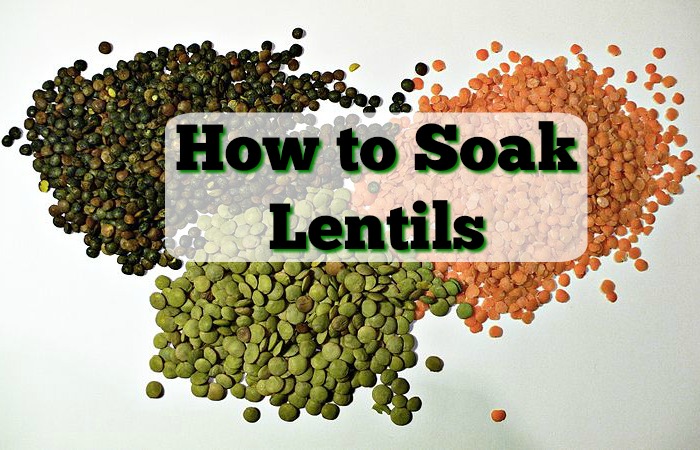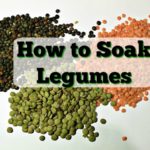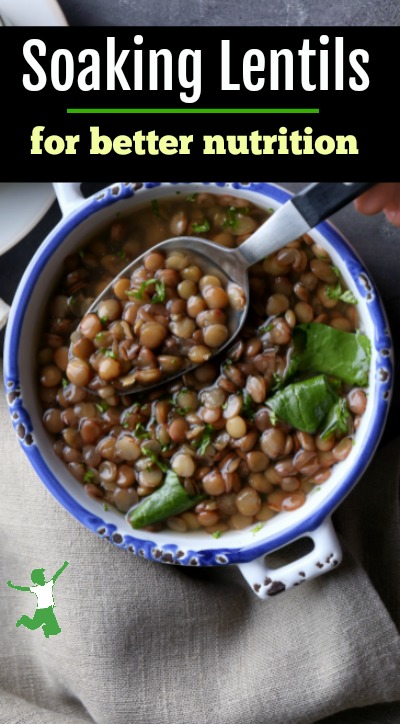Table of Contents[Hide][Show]

Soaking lentils play a critical part in my traditional cooking repertoire. Low in phytic acid and other anti-nutrients, lentils require only a quick soak before they are ready to cook – unlike beans. If you sometimes have trouble digesting beans like I do, even when properly soaked and cooked, lentils are a wonderful alternative.
There are 3 types of lentils: green, brown, and red. I typically use green lentils as they hold their shape very well after cooking, but I have recently found the red lentil to be simply delightful in soups.
When combined in a dish with homemade stock as shown in this week’s video, lentils make an economical, nutritious alternative to meat. The gallon of lentil soup I make in this video only costs about $5 – and I used organic vegetables and organic lentils! This is about 25 cents a serving!
Even the cheapest fast food can’t beat that!
In tough economic times, incorporating lots of lentils into your meals is a smart way to keep the food budget in check without sacrificing anything in nutrition!
Incidentally, Dr. Weston A. Price considered lentils to be the most nutritious of all legumes as they are loaded with potassium,, calcium, zinc, iron, and B vitamins. I first learned this at the 2007 Wise Traditions Conference during Sally Fallon Morell’s talk on “Breakfast, Lunch, and Dinner’. The soup recipe I show you how to make in this video is an adaptation of the lentil soup recipe Sally discussed during that seminar.
I hope you enjoy it as much as my family has over the past few years!
Why Bother Soaking Lentils?
As discussed in the video above, soaking lentils prior to cooking significantly enhances the nutritional value of these tasty legumes. It is a process similar to soaking nuts.
In fact, healthy traditional cultures took great care to soak seeds of all kinds before eating.
Lentils are seeds too!
Soaking virtually eliminates hard to digest lectins, which can cause discomfort and encourage weight gain in some people.
If time is a concern, you can soak large batches of lentils, rinse/low temperature dry and then freeze. This way, when you want to make a recipe using lentils, you can just grab some out of the freezer and cook immediately rather than have to wait several hours or overnight to soak some first.
If you wish to save even more time, you can skip the step requiring soaking lentils and use sprouted lentils instead. I have actually switched over to using sprouted lentils most of the time now that quality organic ones are available at the health food store.
You can use either organic sprouted green lentils or the sprouted lentils trio (black, red, and green lentils). The trio is my favorite.
Be sure to never use the water from soaked beans, lentils, or any other legume for cooking. This modern practice, known as aquafaba, is not traditional. Worse, it is risky to your digestive health.

Soaked Lentils Recipe
Simple recipe for soaking lentils and other legumes to neutralize anti-nutrients so once cooked, their full nutritional value can be enjoyed.
Ingredients
- 3 cups dried lentils green, black or red, preferably organic
- 3 Tbl liquid whey
Instructions
-
Put lentils in a large pot and fill with filtered water.
-
Stir in liquid whey, put lid on the pot and leave on the counter for about 7 hours but no more than 18.
-
Drain soaking water and rinse drain lentils again.
-
Your lentils are now ready for cooking and you may use them in whatever dish you choose or proceed to the next step to make lentil soup.
Recipe Video
Recipe Notes
Red lentils basically disintegrate after cooking, so only soak them for use in soup recipes.
Apple cider vinegar or lemon juice may be substituted for the liquid whey.
This recipe works for split peas too!

Recipes Using Soaked Lentils
Once you have a pot of soaked lentils ready, try using them as a base for this curried lentil soup.
Another recipe to try using soaked lentils is German lentil soup.
Reference








Hi Sarah, I soak all grains and legumes first in pure water for 24 hours, rinse them and soak with a fermenting ingredient for 24 hours more. Do you think it is better or not? Why shouldn’t we soak them no more than 18 hours?
Soaking for as long as you do risks them going sour and/or mold issues. They won’t taste very good once you cook them if you soak too long, I tell you this from experience! I would skip the first soak that you do and just soak with the water and the whey or baking soda.
Thank you, Sarah! Which option would you recommend for someone who can only eat a few pureed vegetables, protein powder, and coconut manna each day? I need to get a new food in asap but don’t want to make it overwhelming but also as successful as possible. 🙂
If you are that sensitive, I would recommend soaking sprouted lentils and then cooking thoroughly. Blending them into bone broth to make soup would make it even easier to digest. Here’s a recipe to consider. https://www.thehealthyhomeeconomist.com/hearty-and-nourishing-german-lentil-soup/
So is it best to not soak sprouted lentils or should they ideally be soaked first as well? Thank you!
You can absolutely soak sprouted lentils to improve digestibility even further. But, using sprouted lentils without soaking is fine too.
Sarah, thank you for sharing all your wisdom and experience. I really appreciate it and have greatly benefited from your resources.
Olive oil is NOT for cooking. It’s ONLY for salads. Educate yourself!
I have educated myself. I’ve also traveled to Italy to see what they do with it traditionally. https://www.thehealthyhomeeconomist.com/cooking-with-olive-oil-yea-or-nay/
https://www.thehealthyhomeeconomist.com/extra-virgin-olive-oil-like-never-seen-or-tasted-before/
Guess what? They cook with it.
Hi Sarah. Please could you explain ambit more about the low heat drying before freezing? Is this done in the oven or just by leaving the lentils out on the bench to dry. Thanks so much!
You dry in a warm oven no hotter than 150F. You can also use a food dehydrator. Do not just leave them out or they will mold and go bad long before they dry!
I had 1 1/2 C of green lentils and did not want to boil water as my AC struggles enough to keep it cool in my apartment. In 5 hours of soaking they were soft and perfect! Tomorrow I’ll throw them in with a vegetable broth, red wine, and black pepper. Thanks!
Amazing for all your knowledge you still heat olive oil………..get with the program!
Cooking with olive oil is not a black or white issue: https://www.thehealthyhomeeconomist.com/cooking-with-olive-oil-yea-or-nay/
Nice recipe, I use green or red (sometimes a mixture) to do something very similar. However, I would say that it’s a good idea to first heat the spices gently (saute temp) for a minute in a little oil, then add the veg and toss it in the spiced oil before leaving them to sweat and sweeten. Many spices actually need to be heated/toasted or they can slightly irritate the gut lining (actually applies to black pepper n particular, believe it or not). This is why garam masala is used in Indian cooking – it’s a combination of the most commonly used spices which are toasted before grinding so they can be added during or even at the end of cooking.
Thank you SO much for putting this content out there! I am grateful for your efforts to share this important information.